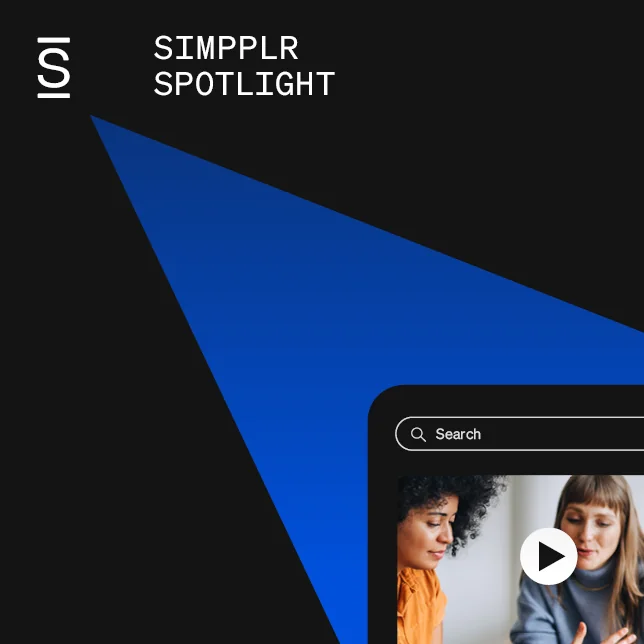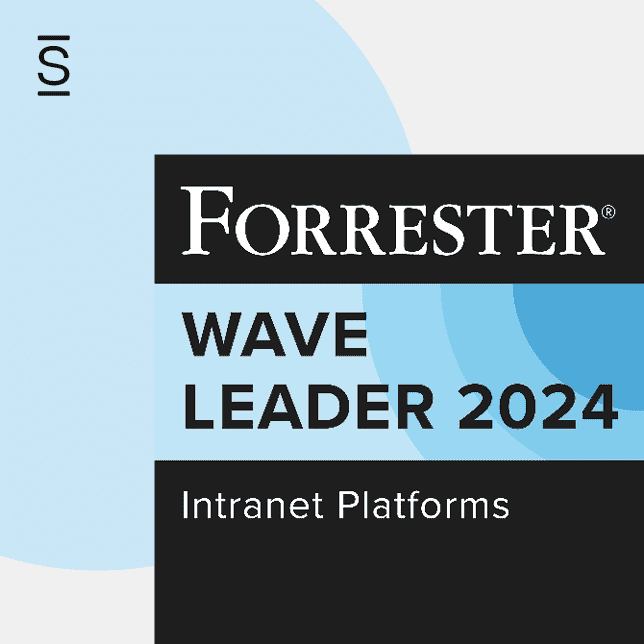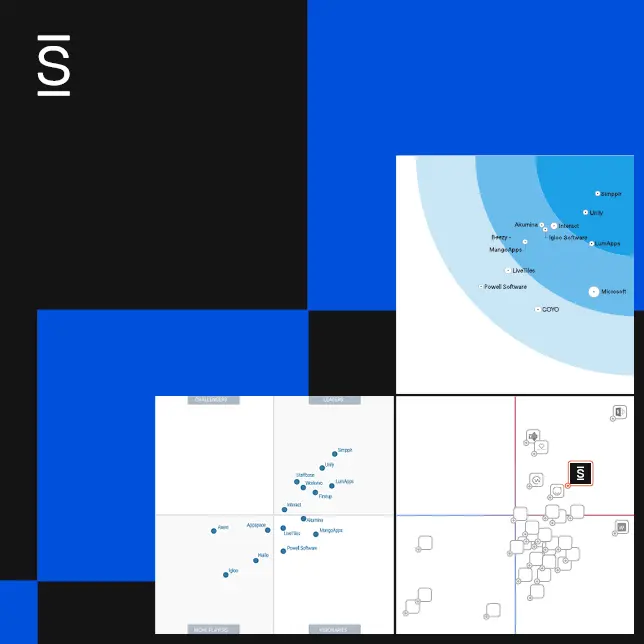If you’re considering purchasing an intranet solution for your organization this quarter, the G2 employee intranet software report can help you make the right decision. It’s the gold standard for provider rankings!
G2 is the largest and most trusted software marketplace. It’s where business professionals, investors, analysts, and buyers like you go to compare and evaluate different software products and services. The site receives more than six million monthly visits from people looking for insights gained from actual, verified user feedback.
Every quarter, G2 analyzes and ranks the top employee intranet software solutions. The solutions and vendors behind them are ranked based on customer satisfaction scores (from verified user reviews) and market presence (per market share, vendor size, and social impact). From the analysis, each product and vendor is placed into one of four grid quadrants: High performers, Leaders, Niche, and Contenders.
- High performers are brands with high customer satisfaction scores and low market presence scores compared to the rest.
- Leaders boast high ratings from G2 users and substantial market scores. We are proud to announce that Simpplr ranks highly in both categories.
- Niche brands have relatively low satisfaction scores and low market presence compared to the rest.
- Contenders are brands with relatively low customer satisfaction scores and high market presence compared to the rest.
Download our latest G2 report here for free, but before you go, let’s briefly discuss some key things to keep in mind as you continue looking for an employee intranet solution.
Why to buy an intranet instead of building it?
Simpplr ranks among the buy intranet solutions. This means we come as an out-of-the-box solution ready to install. It’s one of the reasons why our clients start seeing results in days, not months. And since it requires minimal customizations to configure to your organization’s unique needs, it is also much less expensive than building an intranet from scratch.
Building an intranet from scratch is involving, expensive and time-consuming. First, you must assess your organization’s needs, likely consulting with third parties so everything is covered. Then you must assemble the necessary resources, including a platform, which is like a kit with the necessary components ready to be pieced together by a technical team.

Expect the deployment alone to take at least 12 months. However, it’s more likely to take up to two years, depending on the unique functionalities in aspects like integrations, workflow management, and cross-device optimization. Once it goes live, you need a stand-by technical team to maintain and update it. Unless the needs are extremely specific, most organizations choose the buy option.
Advances in technology and continued research allow intranet providers to anticipate the needs of modern businesses to create reliable out-of-the-box solutions. However, the decision is not made yet as this category is dominated by more than 100 providers with distinct offerings. Resources like the quarterly G2 report come in handy for narrowing down the list of options.
What should you be looking for in a top intranet solution?

To procure the best intranet for your organization, consider the following tips:
- Must-have features
Firstly, what features do you need; what are the must-have features for an employee experience platform? If you want to update your current intranet to a more efficient one, start by looking at the useful features. Collect feedback from employees to better understand what the current platform lacks.
Some of the most important features of an intranet are messaging capabilities, newsfeed, social features, document management, file sharing, search functionality, organizational chart, multi-language support, and customization capabilities.
- Time to value
A vendor’s commitment to deployment time can be very informative on what to expect. If they can take the intranet live in a few months, it’s a sign that they require heavy customization. This means you’re not getting an out-of-the-box solution, which might cost more than the initial quote. The deployment should be dictated by your internal timelines, not the vendors.
Also, ask for references from complex enterprise customers to understand how they handle big projects.
- User experience
The intranet should provide a user-friendly interface to encourage adoption. It should be aesthetically appealing and easy to navigate. Test things like sending a message between colleagues, reading the newsfeed, and finding relevant information.
Ensure the platform is navigable via mobile devices without losses in UX. This will be important, especially for deskless workers who are not always near a computer.
- Ease of governance
Poorly governed intranets quickly become content dumping grounds and die. The admin team is helpless in the face of a poorly designed intranet. Look for solutions that have advanced governance features.

- Client reviews
Unbiased intranet reviews supplement the information you have from the vendor’s site, giving you a fuller picture of the platform before you commit. Beyond the positive reviews and testimonials on the site, visit reputable third-party sites like G2, Software Advice, and Capterra. You can go even further and find specific people that you know work in companies that are clients of the provider, e.g., if Company X is a Simpplr client, find the IC manager on LinkedIn and ask them a few questions.
- Quality of support
Customer service is essential when working with an intranet vendor, like in other products. If your intranet is committed to being on standby for any technical issues and providing regular updates, you want to ensure they will follow through. The best providers will be partners and consultants rather than a simple hotline.
- Security
You cannot compromise your intranet’s security. Poor security endangers the organization, employees, customers, suppliers, and other stakeholders. When vetting vendors, you want guarantees. There are different security protocols necessary in an intranet. They include SSL encryption, SSO authentication, security certificate (e.g., ISO 27001), secure storage sites, and GDPR compliance.
- Integration
As most organizations are in the middle of digital transformation, you want your intranet to easily integrate with third-party digital tools you already use or may use in the future. Robust intranets have this capability as it improves their core communication, collaboration, and knowledge management functions.
- Analytics
The level of insight you can get from your intranet determines how much better it gets with time. You need deep insights into how people use the platform from the feedback they give directly to the data collected in the background. With current technological advances, you can demand even more: You can demand that your intranet analyzes and recommends proper actions.
Tied to this is the quality of reporting, from the live dashboard to customizable reports.
- Pricing
While the pricing isn’t necessarily a predictor of how good the intranet vendor is, you must work within your budget and protect your organization from exploitative pricing arrangements.

Potential intranet challenges to deal with
From decision time to procurement to implementation, it’s not an easy task to get an intranet up and running. Some of the challenges you can expect to meet along the way are:
- Unengaged executives
The decision to buy an intranet must come from the leadership. In many organizations where intranets fail, this decision is left to one department or an individual, such as IT. Effective intranets are backed by all the executives, including HR, IC, IT, and the CEO.
As the champion for the idea, you may have to convince the other executives of its value before they can buy in.
- Slow adoption
Another crucial factor of success is the rate of adoption by the employees. You want a good number of the staff to adopt it quickly – the threshold will depend on the size of your organization. This is usually a challenge when the purpose of the intranet is not defined, or the platform is poorly designed.
- Governance
Unclear ownership and governance are top issues for intranets, higher than any technical or functional issues. Without a systematic approach that starts with governance, three mistakes are bound to follow:
- The isolated, impulsive purchase forced by lack of consultation and buy-in
- The set-it-and-forget-it approach leads to an abandoned-house scenario
- The Frankenstein intranet with multiple objectives rather than a clear purpose
Why Simpplr ranks highly in the G2 intranet report
Simpplr is consistently named Leader for G2’s Employee Intranet Software category. This means the platform is rated highly by users and has substantial market presence scores. In this report, Simpplr also got a Momentum Leader badge. Momentum Leader badges are awarded to the top 25 percent of a category’s products.
As a leading employee experience platform, Simpplr allows businesses to connect, align, and engage entire workforces across enterprises of all sizes. It offers real-time insight to optimize communication, collaboration, and knowledge access, helping companies provide the optimal work environment to employees in the office, the field, or at home.
By helping you create a company culture where employees feel connected, enabled, and included, Simpplr makes it easy to attract, engage, and retain top talent, especially during the current talent shortages.
Here are some of our key capabilities:
- An easy-to-use UX that is managed with clicks, not code
- Smart search functionality that makes content easy to find
- Rapid deployment that takes days, not months
- The industry’s first Auto-Governance engine to make work easier for admin
- Prescriptive analytics to guide improvements
- Flexibility, scalability, and security for organizations of all sizes
- Zero failed adoptions after more than 1000 clients
Download the G2 Employee Intranet Software Report to see how we’ve done compared to other options. And to learn more about Simpplr, reach out for a demo.

















